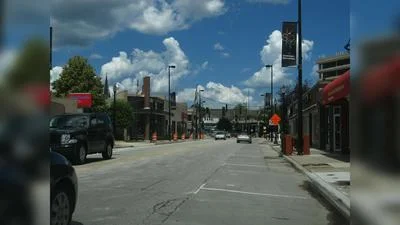Sarah Kellerman (left) and Marisa Schulz | youtube.com/watch?v=25hpiuQcwKY
Sarah Kellerman (left) and Marisa Schulz | youtube.com/watch?v=25hpiuQcwKY
The city council of Evanston voted unanimously during its May 8 meeting to move forward with a retail district plan to improve all eight of its business districts.
Prior to the vote, city officials heard a final presentation on the Evanston Thrives Retail District Action Plan.
The plan has been in the works since September 2022 when research and community engagement activities started gathering information regarding the interests of the residents in each of the eight districts. Along with filing the report in city archives, the council also voted on allocating $3 million from their ARPA funds to implement the recommendations from the report, and to authorize the city manager to add a new employee in the economic development division to aid in this process.
Sarah Kellerman of Interface Studio, a city planning firm, and Marisa Schulz from All Together Studio in Illinois, presented their recommendations to the council. They detailed their community engagement plans to determine how individual and overall business districts in the city could change and improve to better serve the community. The plan calls for the city to invest in unique neighborhood identities.
Kellerman informed the council that, "$3 million doesn't get you far. However, and I think this is a really important point, one of the things that I think Evanstonians need and these retail districts need is a vote of confidence and a little boost. You know, some real commitment by the city to be a partner, to commit to doing things differently and a show of that commitment and confidence."
According to Kellerman, the plan requires council members to “reimagine our neighborhood business districts, balancing market realities with bold and creative design. Protect and reinforce our city’s most precious assets at the neighborhood level. Celebrate the unique identity of each district — past, present and future stories — through branding and placemaking. Identify the ideal use of ground floor space for each district and citywide. Build a toolkit to ensure more equitable investment and support for local businesses.
“So our charge was to look at each of Evanston's retail districts as individual districts, and as a whole, to evaluate their market position in the region and to look at sort of the larger retail ecosystem and its supporting infrastructure,” Kellerman explained. “And that's exactly what we did. So what came together at the end as an end product is a document that's organized into five sections [which] are business supports, events and programing, tenant and attraction, marketing, and then placemaking. Within each of these sections we do a deep dive, but all organized similarly around recommendations followed by actions in the full plan document.”
The recommendations received a unanimous 8-0 to adopt the recommendations, though many aldermen agreed that the $3 million coming from their remaining ARPA funds will not be enough in the long term. The council also placed two items for final consideration on the agenda for the May 22 meeting: another amendment to their ban and charge for single use plastic bags in stores, and a fair workweek resolution that places restrictions on scheduling and employee shifts for businesses in the city.






 Alerts Sign-up
Alerts Sign-up